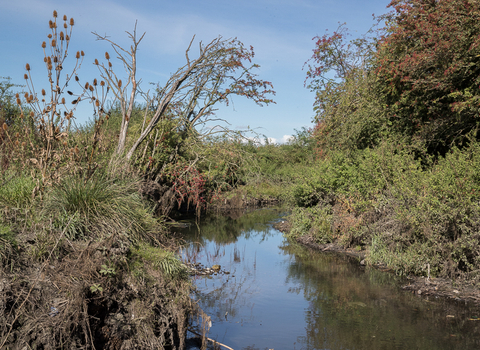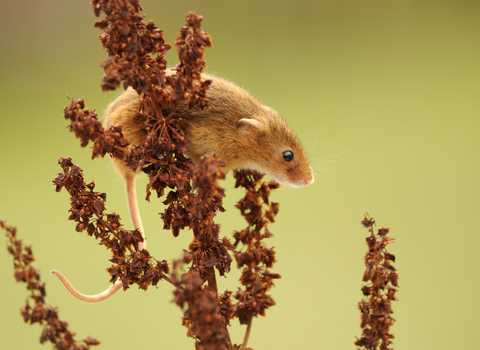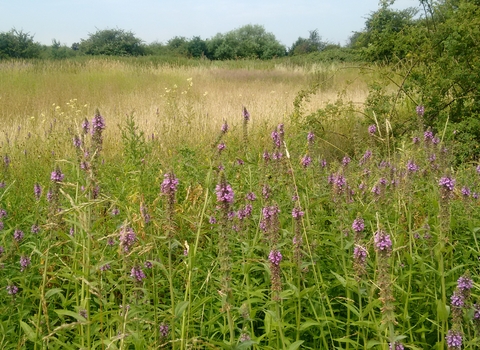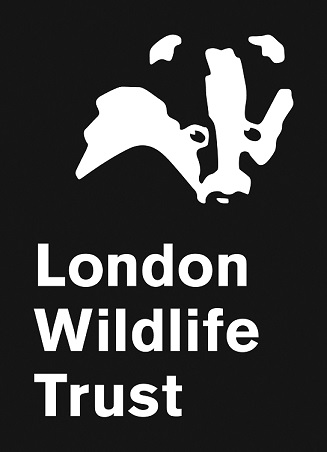New Fund! Rewild London Fund round 3
The Rewild London Fund round 3 launched in autumn 2023. This next round of the fund includes a commitment by the Mayor of London of a further £710,000 to support new rewilding projects in the capital. The chosen projects will start in January 2024 and should be completed by March 2025. Applications for this round are now closed.
London Wildlife Trust, in partnership with the Mayor of London, is supporting projects which will enhance and restore London’s Sites of Importance for Nature Conservation (SINCs). These sites make up London’s wildlife network and a core focus when taking action to rewild and recover nature in the city.
Rewild London Fund round 2: successful projects
Successful applicants of the Rewild London Fund round 2 were granted funding to improve, restore or create wildlife-rich habitats that will address the effects of climate and ecological emergency. The £850,000 fund, delivered in partnership with London Wildlife Trust was made possible with funding from the Mayor of London and Amazon’s Right Now Climate Fund. The 22 successful projects will restore or create around 116 hectares of priority habitat.

Photo credit: Penny Dixie
Yeading Brook Unbound (London Borough of Harrow lead)
As part of the Crane Valley Partnership and in collaboration with local groups and volunteers, Harrow Council’s ambitious, large-scale Yeading Brook Unbound project will make lasting changes - both major and minor - to the brook, its margins and adjoining areas within SINCs, parks and neighbouring allotments along the watercourse.
Photo credit: David Parkyn
Bringing Beavers Back to Ealing
Citizen Zoo alongside Ealing Wildlife Group, Ealing Council and Friends of Horsenden Hill is reintroducing beavers back to west London after a 400 year absence. The chosen site in Ealing will be transformed into a flourishing and immersive wetland, combatting the climate crisis and creating a biodiverse ecosystem for plant and animal diversity. Rewilding will help drive the project forward.

Photo credit: Amy Lewis
Harvest Mouse Reintroduction Project
Perivale Wood is a Site of Metropolitan Importance and is Britain's second oldest nature reserve. The Selborne Society will create new and improved habitats for harvest mice at Perivale Wood, into which harvest mice will be reintroduced. The project will also create wildlife corridors linking the existing population at Horsenden Hill to the habitats at Perivale Wood and railsides to the south.

Wilding City Gardens
City of London’s Wilding City Gardens programme aims to review the City’s existing SINC habitats and upgrade their status through creation of priority habitats, such as species-rich meadows and standing water. The project will investigate climate resilient meadow habitats and the provision of useful wildflowers for the target species in the City’s Biodiversity Action Plan, and where possible create new standing water features.
Full list of projects by borough:
Pan London
London Water Vole Recovery
Led by Zoological Society of London, this project will build a partnership to complete the essential first steps toward recovering water vole and managing mink in London. The aim is to benefit all river corridor SINCs in London and build a strategic regional approach to support wider rewilding objectives.
The partnership project will complete a water vole in London status report. This project will include an assessment of baseline water vole data, a communications campaign requesting sightings of water vole and mink, bringing all current London populations into the National Water Vole Monitoring Programme, and training in water vole survey methods.
Once widespread, the water vole (Arvicola amphibius) is now the UK’s fastest declining mammal. In London, remnant populations still exist but we do not have a clear idea where they are and if they are being monitored. One of the principal causes of the disappearance of water vole is the introduced highly damaging invasive American Mink (Neovison vison) so the project will also plan how we can work collaboratively to remove mink.
Multiple boroughs – Wimbledon, Merton, Kingston-upon-Thames
Restoring the Commons Wetlands: Ponds & Reedbeds
Wimbledon and Putney Commons are 460 hectares of open green space in south-west London. They are managed and owned by a charity, Wimbledon and Putney Commons Conservators (WPCC).
The Commons have a rich array of habitats and are designated a Site of Special Scientific Interest and a Special Area of Conservation. WPCC is embarking on a major conservation project to improve the ponds and other wetland habitats. This project will deliver the survey and design phase of restoring Queensmere, one of the Common’s largest ponds, which is far from reaching its full potential for wildlife. Rewild London Funding will help to design reedbed habitat creation in line with London Environment Strategy targets, ensure the pond and surrounding landscape are more resilient and can support increased biodiversity plus build skills and knowledge for managing the ponds and surrounding habitats.
Multiple boroughs - Hackney & Waltham Forest
Old Lea River Restoration Project
Protected on both banks by Metropolitan Open Land, the Old Lea is the wildest, most natural area in Hackney. The apparent remoteness and scenic grandeur that belies the urban setting is one of the reasons for the river’s recent popularity that has caused accelerated bank compaction and erosion, disturbance of wildlife and locally sourced pollution. This project, created and delivered by the Wildlife Gardeners of Haggerston in partnership with Hackney Council, aims to bring the Old Lea back to health and provide resilience for the future. This will include improving habitat and flow, removal of Invasive Non-Native Species, native species planting, installing in-channel large woody debris and undertaking water quality monitoring. This project will be one of the first in South-East England to use the Urban Riverfly monitoring method.
Multiple boroughs - Harrow & Hillingdon
Yeading Brook Unbound (London Borough of Harrow lead)
Yeading Brook Unbound seeks not only to re-naturalise the western arm of the stream but - within the wider scope of the River Crane catchment - to celebrate what it adds to individual sites for people and for wildlife, now and for the future, and the connection it provides between them. Working closely with parks and allotment groups, Harrow Nature Conservation Forum, the Crane Valley Catchment Partnership, and the Environment Agency, Harrow Council by ‘rewiggling’ the stream or creating more natural banks - benefitting wildlife and reducing flood risk, undertaking instream interventions and ‘daylighting’ the water, tackling scrub encroachment and invasive species that impact adversely on water quality and on wildlife.
The project will focus on a c. 3.5 km of the watercourse between Headstone Manor and Roxbourne Park, identifying major works for contractors and creating survey, monitoring, training and practical opportunities for volunteers.
Barking & Dagenham
The Chase LNR Wetland Restoration Phase 2
The Chase Local Nature Reserve is a biodiversity haven in an otherwise urban location. It is in easy reach of communities within the London Boroughs of Barking & Dagenham and Havering and is a vital component in the jigsaw of open spaces and habitats across this landscape. The funding enables London Borough of Barking & Dagenham to undertake further habitat enhancement at the reserve – more reedbed habitat will be created, water levels will be managed and work undertaken to manage invasive species.
Year two of this project is still focusing on The Slack Bird Sanctuary, which is a wide shallow wetland at the heart of The Chase LNR and a leading reason for designation as a Site of Metropolitan Importance.
Rewilding for Reptiles
Beam Parklands is a biodiversity haven and forms the southernmost part of the Dagenham Corridor. This 53-hectare site is managed by The Land Trust in partnership with the London Borough of Barking & Dagenham. The site comprises a mosaic of habitats including species rich acid grassland, river, ponds, woodland, and scrub.
Recent reptile sightings have highlighted the opportunity to undertake a focused programme of works to identify reptile and amphibian populations and where there is potential to increase populations across these SINCs, to carry out targeted habitat works. These works will also, more broadly, improve habitats and create corridors for a wider range of species. Public engagement and education on reptiles will be a core part of the project.
Bexley
Thamesmead Pollinator Corridor
This is a partnership project between North West Kent Countryside Partnership (NWKCP), The Ridgeway Users Group, University Of East London, Bow Arts and Bumblebee Conservation Trust (BBCT) to work with communities, creating a pollinator corridor through Thamesmead.
The partnership will be working with local volunteers and members of the community to carry out habitat improvements and people will be invited to learn more about bumblebees and other pollinators through a series of workshops and events as well as have a chance to feed into the interpretation and signage at the site.
The project aims to boost numbers of the rare shrill carder bee and other pollinator species by increasing the abundance and diversity of forage plants and nesting sites. Habitat improvements will take place in a range of green spaces including school grounds, community gardens and balconies as well as local authority/Thames Water owned land such as The Ridgeway.
City of London
Wilding City Gardens
City of London’s (CoL) Wilding City Gardens programme aims to review the City’s existing SINC habitats and upgrade their status through creation of priority habitats, such as species rich meadows and standing water features. The project will investigate climate resilient meadow habitats and the provision of useful wildflowers for the target species in the City’s BAP, and where possible create new standing water features. It will complement the City Greening and Biodiversity Project, an integral part of the Cool Streets and Greening (CSG) programme (part of the CoL Climate Action Strategy).
Ealing
London Borough of Ealing SINC Meadows Improvements
Led by London Borough of Ealing, this project will enhance SINCs in Ealing and contribute to the London Environment Strategy habitat targets of 50Ha of flower-rich grassland (in addition to Ealing’s BAP targets). The project will improve and expand a significant area of native wildflower meadows by addressing historic scrub encroachment and subsequent wildflower seed-sowing (including yellow-rattle). This funding will also facilitate effective ongoing site management through the provision of much needed equipment and expertise.
Bringing Back Beavers to Ealing
Citizen Zoo, alongside Ealing Wildlife Group, Ealing Council and Friends of Horsenden Hill, is reintroducing beavers back to West London after a 400-year absence. The chosen site in Ealing will be transformed into a flourishing and immersive wetland, combatting the climate crisis and creating a biodiverse ecosystem for plant and animal diversity.
In 2021 the London Beaver Working Group was established, working to prepare for the natural or assisted return of beavers to the capital. This included a year-long investigation into potential reintroduction sites.
Rewild Funding will help drive the project forward through physical preparation of the chosen site, baseline surveys and establishing monitoring activity. Additionally, a new role will be recruited to manage the project and continue engagement with the local community.
Harvest Mouse Reintroduction project
Perivale Wood is a Site of Metropolitan Importance and is Britain's second oldest nature reserve. The reserve comprises 27 acres of mostly ancient oak woodland, with 5 acres of neutral unimproved grassland and several ponds. The Selborne Society, one of Britain's oldest conservation organisations, owns and manages Perivale Wood.
This project will create new and improved habitats for harvest mice at Perivale Wood, into which harvest mice will be reintroduced. The project will also create wildlife corridors linking the existing population at Horsenden Hill to the habitats at Perivale Wood and railsides to the south. The project will support improvement of the harvest mice breeding facility at Horsenden Farm including provision of an ecology lab for wildlife surveying and community engagement.
Enfield
King’s Oak Wetlands
The London Borough of Enfield aims to create new wetlands in a rural area of the borough. This forms part of Enfield’s wider landscape restoration proposals, building on the success of the first phase which delivered 100,000 trees across 60 hectares and over 40 wetland ponds and scrapes (which won the London Tree & Woodland Awards prize for Trees and Water)
The project will build on this approach in the next phase of woodland creation aiming to create four natural flood management ponds into the new woodland.
Hillingdon
Rewilding the Grove
The Grove was once the grounds of a large house on the edge of Hillingdon village. This old Victorian garden is now a site of increasing value for wildlife, aided by the presence of wetland areas. The central feature is a sequence of a wet meadow, one small and one large pond, which runs for much of the length of the reserve. The ground flora, including wetland vegetation in the ponds is restricted by the tree canopy.
Although the ponds and surrounding terrestrial habitats are attractive to a range of amphibians, tree work is necessary in order to allow more direct light to the ponds. London Borough of Hillingdon will use the funding to pollard the mature trees next to the pond, restore/desilt the existing ponds, as well as plant wetland plants. This will provide a restored wetland area for amphibians and aquatic invertebrates and appropriate planting with native wetland species will improve the overall biodiversity.
Lambeth
Rewild Brockwell North
Brockwell Park is a popular open space in London Borough of Lambeth where leisure areas are juxtaposed with habitat including, veteran trees, meadows, and ponds. Improvements will connect habitats across the north side of the park in response to research detailed in the Ecological Planning for Brockwell Park report. This will include creating a new wildflower and grass meadow with banks and rain ponds, planting a belt of trees and native shrubs including a native hedge and damp woodland and trial improvements to the lake margins. Volunteers will be invited to help with tree planting, and to learn from experts in an annual wildlife monitoring programme.
Lewisham
Forster Park Ancient Woodland Restoration Project
The project's overall aim is to restore and maximise the ecological integrity and resilience of the ancient woodland areas in Forster Park, London Borough of Lewisham. To date woodlands have been managed for Health & Safety, retaining deadwood wherever appropriate but resulting in a lack of diversity of woodland floor vegetation and dominance of some competitive species. Activities will include coppicing, scrub clearance and dead hedging as well as more focused project areas that will deliver biodiversity and habitat enhancements. The project aims to increase community involvement in the improvement and management of the park and provide opportunities to improve wellbeing through nature conservation activities.
The Green Line - Nature's Railway - Hedgelaying and orchard restoration
The Buckthorne Cutting Nature Reserve is at the centre of a 4.5km long SINC and is adjacent to Gorne Wood (Ancient Woodland). It already has stag beetles, owls, slow worms and bats. This project will support the restoration of the orchard and the creation of hedgerow helping to sustain wildlife that travel along this corridor while attracting more wildlife. Both projects will also improve health and wellbeing as the nature reserve has daily visits by school children and is open to the public through volunteering sessions, open days and specifically for vulnerable groups such as female refugees and adults with learning disabilities - both groups more likely to have less connection to nature due to financial disadvantage. The project is led by the Fourth Reserve Foundation.
Kingston
Breathing Life Back into the Hogsmill Wood
The Hogsmill Wood was once a much loved Local Nature Reserve and is, a key part of the Hogsmill Valley SINC. Once managed by London Wildlife Trust, the site has had limited management since the early 2000s. This lack of management has resulted in significant site degradation, with issues of fly tipping and litter build up, as well as invasive species such a snowberry and Himalayan balsam dominating areas of the site. Led by Royal Borough of Kingston, the project will produce a restoration plan for the site, run woodland management sessions for volunteers to help improve the ecological health of the woodland, survey the site to better understand its’ ecological condition and seek to establish a Friends Group for the site. The long term aim is to establish safe access to the site and enable its use by groups such as local Forest School providers.
Newham
Beckton Meadow
Newham Council will create a species-rich wildflower meadow at the heart of Beckton District Park as one of the first steps in the realisation of the Beckton Parks Masterplan currently being prepared.
Beckton District Park is the largest area of local authority managed green space in Newham and the largest SINC managed by the borough.
Richmond
Richmond Corridors
Rewild London funding will enable London Borough of Richmond to strengthen environmental links between a network of SINC sites in Hampton and build environmental resilience between sites. This network of green spaces in the west of the borough has high environmental value and includes off-road walking links between and through the sites that form green corridors. Through a range of activities, the project will enhance habitat (including meadows and ponds) within the network of green spaces, improve biodiversity by creating ‘stepping stones’ that better link the ecological network and corridors and work with stakeholders to secure better future management of the SINC sites in the Hampton cluster.
Richmond and Wandsworth
Palewell Beverley Brook Restoration
The Beverley Brook is 14.3km in length. There are virtually no natural parts remaining of the river: the whole length has at some point been altered.
The stretch of river targeted within this project is 1.25km long and runs from Upper Richmond Road to the boundary of Richmond Park. The river here has historically been realigned, straightened, widened, and deepened, changing the course from its former meandering channel to the present. This straightened channel lacks the flow and habitat diversity underpinning a healthy ecosystem and can lead to greater flood risk downstream. Led by Barnes Conservation, part of Barnes Common Limited, the project aims to create a diverse mix of flow types, depths, velocities, widths, and cover in this stretch of the brook. This will create the array of niches that are needed to encourage a more diverse and complex composition of plants and animals to colonise and establish.
Southwark
Improving Biodiversity in Dulwich Woods
Dulwich Wood in combination with neighbouring Sydenham Hill Wood, is the largest remaining tract of the historic Great North Wood in south London. The project, led by The Dulwich Estate, focuses on allowing a variety of woodland species to regrow in trampled and damaged areas of Dulwich Wood. Planned activities include the renewal of footpaths, creation of mixed native hedgerows of oak, hawthorn, hazel, hornbeam, and holly and wildflower planting on grass verges to connect sites. The project aims to extend woodland habitats into existing green spaces and corridors which are not currently functioning optimally for wildlife.
Tower Hamlets
Greening the Wapping Canal
Led by London Borough of Tower Hamlets, this project will install eleven floating rafts with mixed native wetland vegetation along a 220 metre stretch of the south-western section of the Wapping Ornamental Canal alongside Spirit Quay. These will consist of one larger raft designed to accommodate nesting swans in its central section, five rafts which include an unvegetated central section where water birds can nest and/or rest, and five fully vegetated rafts. The rafts will be Biomatrix floating ecosystems, with the plant roots forming habitat and shelter for small fish and aquatic invertebrates.
The Wapping Ornamental Canal is a shallow, vertical-sided waterway leading between Hermitage Basin and Shadwell Basin. It has reasonable amounts of submerged aquatic vegetation, including the London scarcities common stonewort Chara vulgaris and lesser pondweed Potamogeton pusillus, but for most of its length it lacks emergent vegetation or opportunities for water birds to nest or rest.
